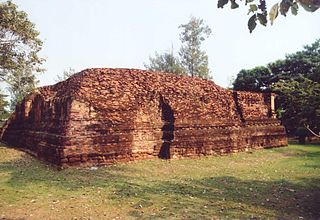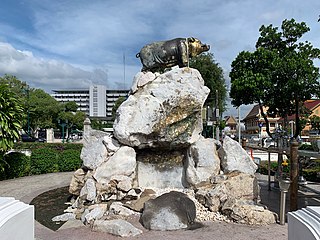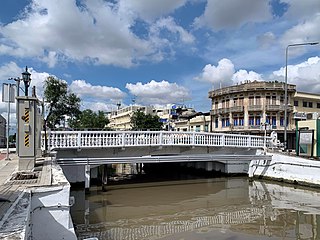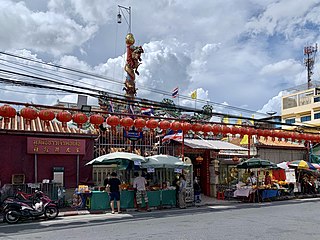Related Research Articles

Historic preservation (US), built heritage preservation or built heritage conservation (UK) is an endeavor that seeks to preserve, conserve and protect buildings, objects, landscapes or other artifacts of historical significance. It is a philosophical concept that became popular in the twentieth century, which maintains that cities as products of centuries' development should be obligated to protect their patrimonial legacy. The term refers specifically to the preservation of the built environment, and not to preservation of, for example, primeval forests or wilderness.

Conservation and restoration of immovable cultural property describes the process through which the material, historical, and design integrity of any immovable cultural property are prolonged through carefully planned interventions. The individual engaged in this pursuit is known as an architectural conservator-restorer. Decisions of when and how to engage in an intervention are critical to the ultimate conservation-restoration of cultural heritage. Ultimately, the decision is value based: a combination of artistic, contextual, and informational values is normally considered. In some cases, a decision to not intervene may be the most appropriate choice.

An ancient monument can refer to any early or historical manmade structure or architecture. Certain ancient monuments are of cultural importance for nations and become symbols of international recognition, including the ruins of Baalbek on Lebanese currency, the Angkor Wat on Cambodian currency and the Great Wall of China on the Chinese currency. There are some countries that display ancient buildings as symbols on their coats of arms as a way to affirm national identity. In this way, ancient monuments in the modern world are used as icons to represent a country. The importance of ancient monuments extends to cultural heritage and how the people of a nation or city identify themselves.

Cultural heritage is the heritage of tangible and intangible heritage assets of a group or society that is inherited from past generations. Not all heritages of past generations are "heritage"; rather, heritage is a product of selection by society.

Khu Bua is an archaeological site located in the Khu Bua subdistrct, 12 km southeast of the city of Ratchaburi, Thailand. It dates from the 6th century Dvaravati culture and was one of the major cities of the kingdom.

A Cultural Property is administered by the Japanese government's Agency for Cultural Affairs, and includes tangible properties ; intangible properties ; folk properties both tangible and intangible; monuments historic, scenic and natural; cultural landscapes; and groups of traditional buildings. Buried properties and conservation techniques are also protected. Together these cultural properties are to be preserved and utilized as the heritage of the Japanese people.
The cultural monuments of the Czech Republic are protected properties designated by the Ministry of Culture of the Czech Republic. Cultural monuments that constitute the most important part of the Czech cultural heritage may be declared national cultural monuments by a regulation of the Government of the Czech Republic. Government may also proclaim a territory, whose character and environment is determined by a group of immovable cultural monuments or archaeological finds, as a whole, as a monument reservation. Ministry of Culture may proclaim a territory of a settlement with a smaller number of cultural monuments, historical environment or part of a landscape area that display significant cultural values as a monument zone.

Saphan Mon is a historic bridge in Bangkok's Phra Nakhon District. It carries Charoen Krung Road across the old city moat, and was originally built in the reign of King Nangklao, presumably by members of the Mon community who lived nearby. In those days, Mon traders used to settle their boathouses in the area of the bridge. During the reign of King Vajiravudh, the original wooden structure was replaced with a reinforced concrete bridge with iron railings demonstrating Art Nouveau influence. The bridge is registered as an ancient monument by the Fine Arts Department.

Phitthaya Sathian Bridge is a historic bridge in the Bangkok's Talat Noi sub-district, Samphanthawong district. It is considered as another steel bridge of Bangkok counterpart with the Damrong Sathit Bridge, popularly known as Saphan Lek, which site in the area of Khlong Thom. Phitthaya Sathian Bridge is the bridge on Charoen Krung road across Khlong Phadung Krung Kasem and formed a border of Samphanthawong with Bang Rak's Maha Phruettharam and Bang Rak sub-districts.

Sommot Amon Mak Bridge is a historic bridge over the khlong (canal) in Bangkok. It's located on Bamrung Mueang road between Phra Nakhon district's Samran Rat sub-district and Pom Prap Sattru Phai district's Ban Bat sub-district.

Pig Memorial is a memorial in Phra Borom Maha Ratchawang sub-district, Phra Nakhon district, Bangkok. It is located in the inner city or Rattanakosin Island which is a historic area of the city.

Chaloem La 56 Bridge, popularly known as Hua Chang Bridge, is a bridge in Bangkok's Thanon Phetchaburi sub-district, Ratchathewi district and Wang Mai sub-district, Pathum Wan district. The bridge crosses Khlong Saen Saep on Phaya Thai Road.

Chang Rong Si Bridge is a bridge and monument in the Rattanakosin Island area at a tripoint between Phra Borom Maha Ratchawang and San Chaopho Suea with Wat Ratchabophit Subdistricts of Phra Nakhon District, the historic centre of Bangkok. The bridge spans Khlong Khu Mueang Doem, the old city moat, and is locate behind the Ministry of Defense and at the front corner of the Ministry of Interior. It signifies the beginning of Bamrung Mueang Road as it continues eastward from Kanlayana Maitri Road. Atsadang Road meets the bridge's eastern foot at the eponymous Saphan Chang Rong Si Intersection, while Rachini Road runs alongside the canal on the opposite side.

The Fine Arts Department is a government department of Thailand, under the Ministry of Culture. Its mission is managing the country's cultural heritage.

San Chaopho Suea (Sao Chingcha) (Thai: ศาลเจ้าพ่อเสือ (เสาชิงช้า)) or San Chaopho Suea Phra Nakhon (ศาลเจ้าพ่อเสือพระนคร), usually shortened to San Chaopho Suea (ศาลเจ้าพ่อเสือ; simplified Chinese: 打恼路玄天上帝庙; traditional Chinese: 打惱路玄天上帝廟; pinyin: Dǎ nǎo lù xuán tiān shàngdì miào; commonly known in English as Tiger God Shrine) is a Chinese joss house located at 468 Tanao Road, San Chaopho Suea Sub-district, Phra Nakhon District in the old town Bangkok (Rattanakosin Island) near Sao Chingcha (Giant Swing) and Wat Mahannapharam with features the Southern Chinese architectural style. It is the shrine of Chaopho Suea (เจ้าพ่อเสือ; lit: Tiger God), according to the ancient Chinese belief and it is one of the most respected Chinese shrines in Bangkok and Thailand alike Wat Mangkon Kamalawat in Chinatown, especially during the Chinese New Year.

Chao Mae Thapthim Shrine is a historic Chinese joss house located at 257 Chakkraphet Road, Wang Burapha Phirom Subdistrict, Phra Nakhon District, Bangkok near foot of Phra Pok Klao Bridge and Phahurat area, also known as Little India.

The Ministry of Defence headquarters is a historic building in Bangkok's Phra Nakhon District. It sits opposite the Grand Palace on Sanam Chai Road, in the heart of the historic Rattanakosin Island. The building, in the neo-Palladian style of the neoclassical movement, was built as the Front Soldiers' Barracks in 1882–1884 to designs by Italian architect Joachim Grassi. It has served as the headquarters of the Ministry of Defence since the ministry's establishment in 1887.
Throughout the world, different laws exist that protect monuments.

The Neilson Hays Library is a privately funded English-language library in Bangkok, Thailand. It occupies a historic building on Surawong Road in Bangkok's Bang Rak District, designed in neoclassical style by Italian architects Mario Tamagno and Giovanni Ferrero. The library traces its origins to the Bangkok Ladies' Library Association, which was established in 1869, but did not have a permanent location until the current building was commissioned in 1921 by resident American doctor T. Heyward Hays in memory of his late wife, Jennie Neilson Hays, who had been an active member of the library board. The building, completed in 1922, features a symmetrical plan, with a domed rotunda originally serving as the entrance hall, and an H-shaped reading room. The building received the ASA Architectural Conservation Award in 1982, and was registered as an ancient monument in 2001. It underwent major restoration work from 2016 to 2018. The library is wheel chair friendly.
References
- ↑ Act on Ancient Monuments, Antiques, Objects of Art and National Museums, B.E. 2504 (translation) (PDF). 1961. Retrieved 5 January 2017.
- ↑ "โบราณสถานทั่วราชอาณาจักร ขึ้นทะเบียน และไม่ขึ้นทะเบียน (ล่าสุด 3กย58)". Fine Arts Department. 3 September 2015. Archived from the original on 6 January 2017. Retrieved 5 January 2017.
- ↑ Lertcharnrit, Thanik (2014). "Thailand: Cultural Heritage Management". In Smith, Claire (ed.). Encyclopedia of global archaeology. New York, NY: Springer. pp. 7287–7293. ISBN 978-1-4419-0465-2.
- ↑ Jansuttipan, Monruedee (31 May 2012). "Architectural Heritage Preservation in Bangkok". BK Magazine Online. Retrieved 5 January 2017.